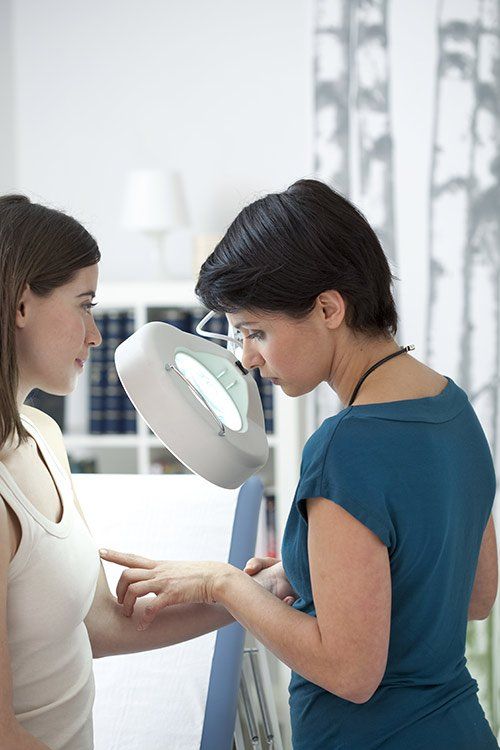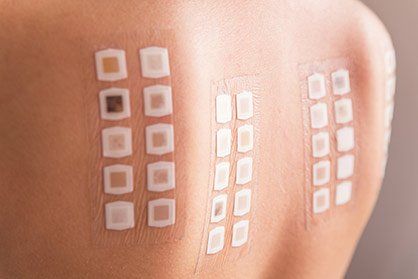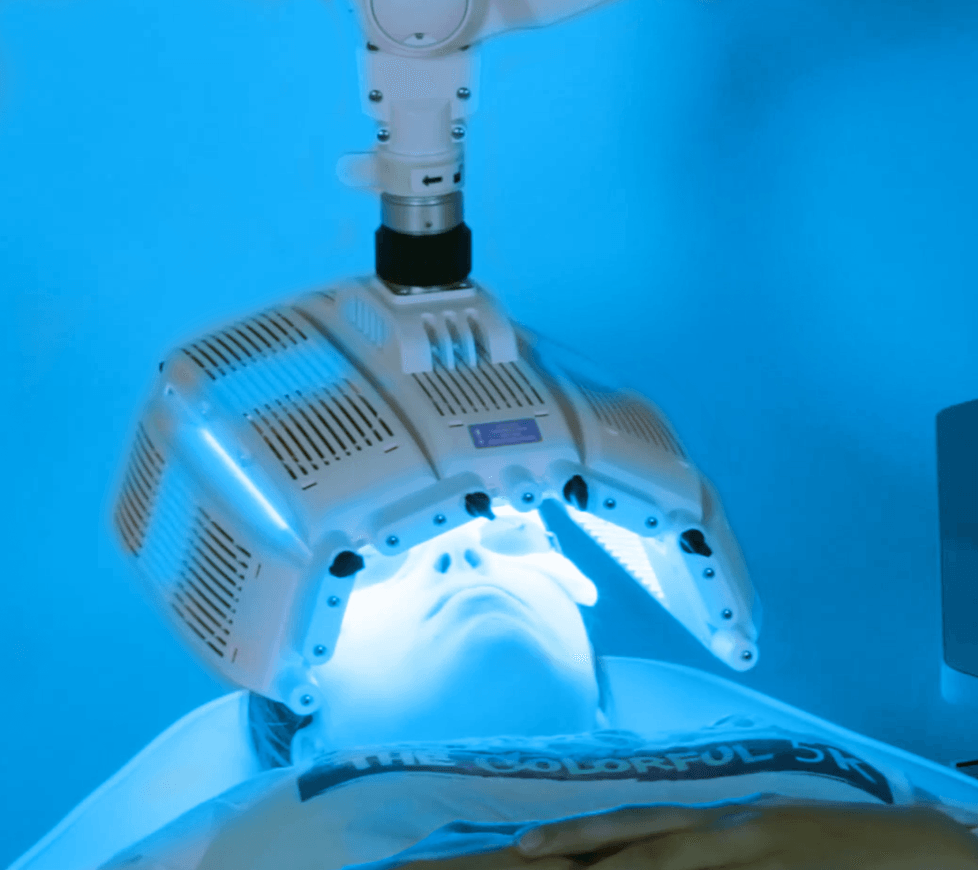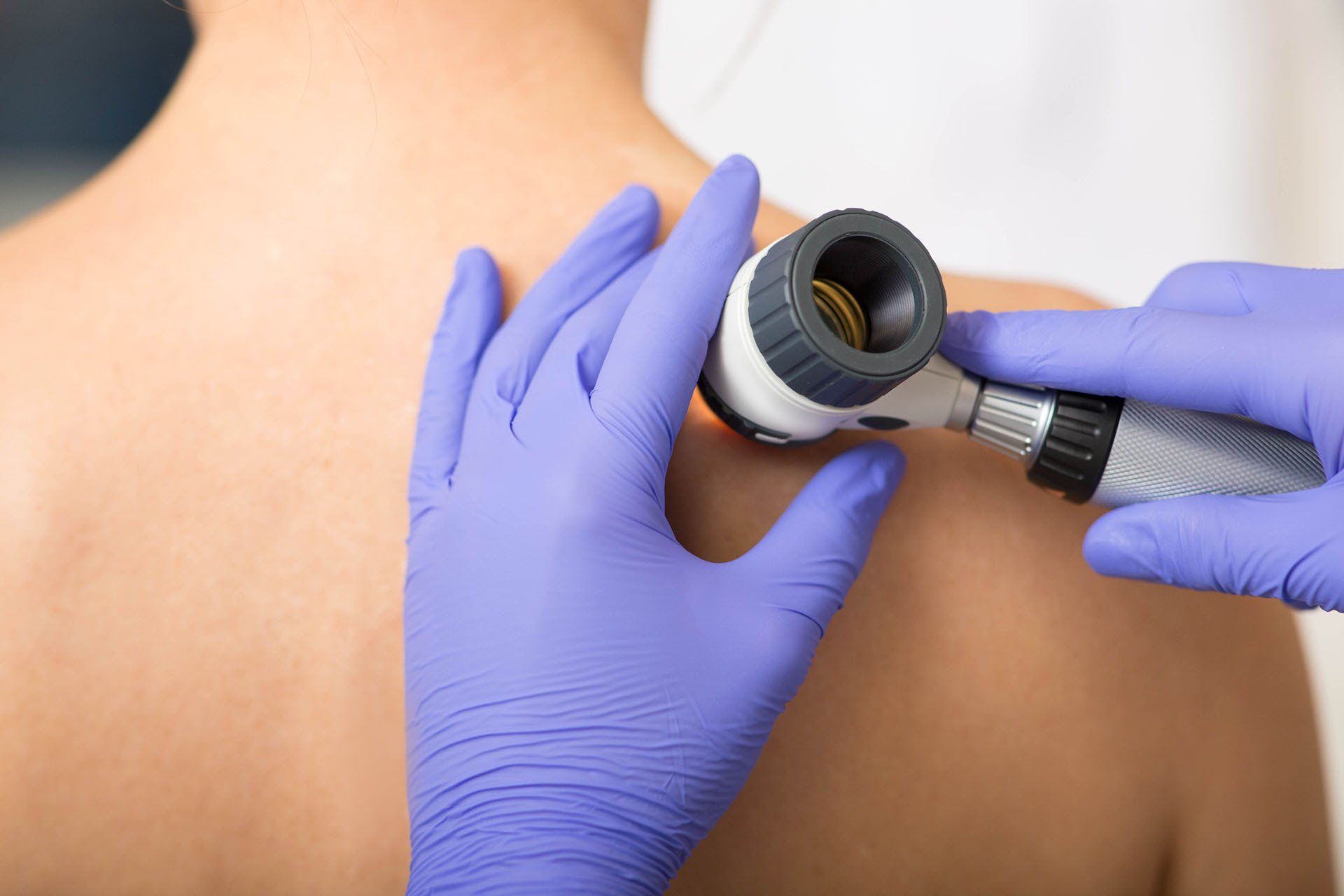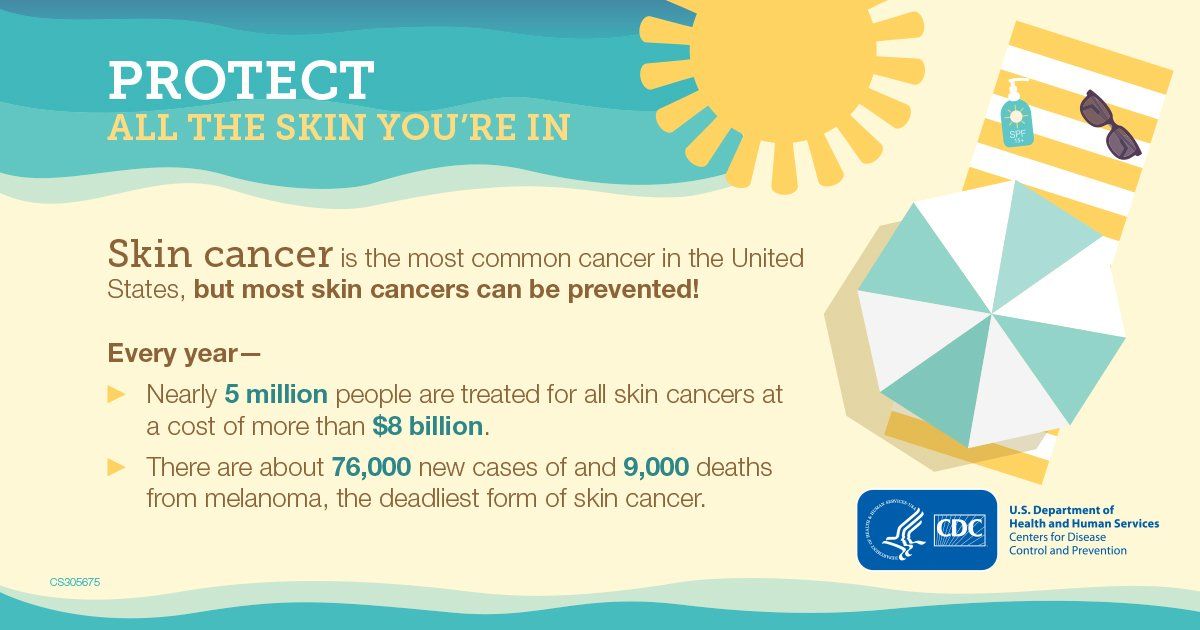Medical Services
Medical Dermatology
Skin Cancer Screening
Skin cancer is the most common type of cancer in the United States. At Dermatology Specialists of Shelby in Shelby Township, Michigan, you can get regular skin cancer screenings to catch lesions and start treatment early. To book your next screening, call Dermatology Specialists of Shelby or book your appointment online today.
Skin Cancer Screenings Q & A
-
Why do I need skin cancer screenings?
You may need a skin cancer screening if you have certain risk factors. Risk factors for skin cancer include having:
- Light skin tone
- Blond or red hair
- Light-colored eyes (blue or green)
- Skin that burns and/or freckles easily
- History of sunburns
- Family and/or personal history of skin cancer
- Frequent exposure to the sun through work or leisure activities
- A large number of moles
-
What are the symptoms of skin cancer?
A change in your skin is the most common sign of skin cancer. This could be a new growth, a sore that doesn’t heal, or a change in a mole. Not all skin cancers look the same.
For melanoma specifically, a simple way to remember the warning signs is to remember the A-B-C-D-Es of melanoma—
- “A” stands for asymmetrical. Does the mole or spot have an irregular shape with two parts that look very different?
- “B” stands for border. Is the border irregular or jagged?
- “C” is for color. Is the color uneven?
- “D” is for diameter. Is the mole or spot larger than the size of a pea?
- “E” is for evolving. Has the mole or spot changed during the past few weeks or months?
Contact Dermatology Specialists of Shelby if you notice changes in your skin such as a new growth, a sore that doesn’t heal, a change in an old growth, or any of the A-B-C-D-Es of melanoma.
-
How do skin cancer screenings work?
Skin cancer screenings are simple. They involve only a visual examination of your skin to search for physical warning signs of skin cancer. You can screen yourself at home if you know what to look for, but screenings by dermatologists are much more thorough because of their training and ability to get a close look at places that you can’t see well using just a mirror.
Moles that may be cancerous exhibit some unusual qualities:
- Changing shape, size, or color
- Bleeding or oozing
- Multicolored
- Pain when you touch it
- Itchiness
- Indistinguishable borders
If you or your dermatologist at Dermatology Specialists of Shelby find a spot that seems unusual, your dermatologist takes a biopsy, or sample, of the affected skin and sends it to a lab for testing. If they find that it’s cancerous, you’ll start an appropriate treatment plan immediately.
-
When should I come in for a skin cancer screening?
Treatment of skin cancer varies according to the location, size, aggressiveness of the cancer and the patient’s general health. In most cases, the dermatologist biopsies a small piece of the abnormal growth for an evaluation to determine whether or not it is malignant. Malignant tumors may require additional treatment.
Skin cancer can develop anywhere on the skin, so act vigilantly to prevent its growth. Ask someone for help when checking your skin, especially in places difficult to see. Seek treatment if you notice a mole that looks different from others, changes, enlarges, itches or bleeds – even if it is small.
To book your next screening, request an appointment by phone or online at Dermatology Specialists of Shelby today.
-
What are the different types of skin cancer?
Atypical (Dysplastic) Nevi (Moles)
Atypical nevi are growths that begin as and resemble moles but develop some of the signs that we usually associate with cancerous growths. Atypical nevi may be irregular in shape or color and may look scaly or crusty. If you notice any growths with this type of appearance, or if a mole changes to one that resembles these characteristics, it is important to have it checked by your dermatologist immediately.
Actinic Keratoses (AKs)
Actinic Keratoses (or solar keratoses) are considered the earliest stage in the development of certain skin cancers. AKs are small, scaly spots most commonly found on the face, ears, neck, forearms, the scalp and backs of the hands in fair-skinned individuals who have had significant sun exposure. Some AKs may progress to advanced stages that require more extensive treatment. There are many effective treatments for AKs including medications, cryotherapy, laser or light therapy and chemical peels.
Basal Cell Carcinoma (BCC)
Basal Cell Carcinoma is the most common type of skin cancer. It occurs most frequently on the head and neck, but also on the trunk and lower limbs. BCC often appears as a fleshy bump, nodule, or red pearly patch. BCCs are frequently found in fair-skinned individuals. BCCs usually grow slowly, but this does not mean treatment should be delayed. While BCCs rarely metastasize (spread) to other organs, if untreated, they often will begin to repeatedly bleed and crust over, and can extend below the skin to the muscle, bone and nerves causing considerable local damage. There are several treatments available for BCC depending on the size, type, and location.
Squamous Cell Carcinoma (SCC)
Squamous cell carcinoma is another common skin cancer that is most often caused by sun exposure. If detected early it is easily treatable with in office excision or other treatments. If left untreated, SCC can rarely spread to lymph nodes or other organs of the body. Other risk factors for SCC include extensive burns, repeated exposures to radiation or x-rays, certain viral infections, and alcohol or tobacco use.
Melanoma
Melanoma is a type of malignant skin tumor. Skin color making cells called melanocytes become cancerous, grow, and invade other tissues. This is one of the most severe forms of skin cancer and if left untreated will be fatal. People with a family history of melanoma may be at an increased risk. Melanoma can appear anywhere on the body and can present as a change in an existing mole or appearance of a new, unusual mole.
ABCDEs of Melanoma Detection:
- Asymmetry. If you could fold the lesion in two, the two halves would not match.
- Border. Melanomas often have uneven or blurred borders.
- Color. Melanoma typically is not one solid color; rather it contains mixed shades of tan, brown, and black. It can also show traces of red, blue or white.
- Diameter. While melanomas are usually greater than 6 millimeters (about the size of a pencil eraser) when diagnosed, they can be smaller. If you notice a mole different from others, or which changes, itches, or bleeds even if it is smaller than 6 millimeters, you should see a dermatologist.
- Evolving. Sudden elevation. Evolving or changing mole.
Cutaneous T-Cell Lymphoma
This is a type of lymphoma (cancer of the white blood cells) that shows itself in problems with the skin. It is a disease that is throughout the body, but shows up most in the skin and connective tissue. It is diagnosed by taking a sample of the growth or lesion that is on the skin.
MOHS Micrographic Surgery
MOHS surgery is performed by our Board Certified Dermatologists who specializes in MOHS surgery. Mohs surgery has come to be accepted as the single most effective technique for removing Basal Cell Carcinomas and Squamous Cell Carcinomas (BCCs and SCCs), the two most common skin cancers. It accomplishes the nifty trick of sparing the greatest amount of healthy tissue while also most completely expunging cancer cells; cure rates for BCC and SCC are an unparalleled 98 percent or higher with Mohs, significantly better than the rates for standard excision or any other accepted method.
The reason for the technique's success is its simple elegance. Mohs differs from other techniques in that microscopic examination of all excised tissues occurs during rather than after the surgery, thereby eliminating the need to "estimate" how far out or deep the roots of the skin cancer go. This allows the Mohs surgeon to remove all of the cancer cells while sparing as much normal tissue as possible. The procedure entails removing one thin layer of tissue at a time; as each layer is removed, its margins are studied under a microscope for the presence of cancer cells. If the margins are cancer-free, the surgery is ended. If not, more tissue is removed from the margin where the cancer cells were found, and the procedure is repeated until all the margins of the final tissue sample examined are clear of cancer. In this way, Mohs surgery eliminates the guesswork in skin cancer removal, producing the best therapeutic and cosmetic results.
Biologic Treatments
Content coming soon
Phototherapy
While you’re advised to stay out of the sun due to the damage it causes to your skin, certain bands of sunlight help treat many chronic skin conditions, such as psoriasis and vitiligo. Phototherapy at Dermatology Specialists of Shelby in Shelby Township, Michigan, is a treatment that provides the bands of light your skin needs to alleviate your symptoms. To learn more about the benefits of phototherapy, contact Dermatology Specialists of Shelby by phone or online today.
Phototherapy Q & A
-
What is phototherapy?
Phototherapy, also referred to as light therapy, is a treatment available at Dermatology Specialists of Shelby used to treat certain chronic skin conditions that don’t respond well to traditional treatments. The band of light used for phototherapy is ultraviolet B (UVB), which is the middle band of light between the UVA (tanning light) and UVC (germ-killing) rays.
Many chronic skin conditions develop due to an overreaction of immune cells. The UVB light works by suppressing the immune cells in your skin to reduce the reaction.
-
Am I a good candidate for phototherapy?
The team at Dermatology Specialists of Shelby determines if you’re a good candidate for phototherapy during your evaluation. The team may recommend phototherapy to treat:
Psoriasis
Psoriasis is a skin condition in which your skin cells grow at an abnormally fast pace, creating red, scaly patches of skin. You may benefit from phototherapy for your psoriasis if your condition is severe and traditional treatments aren’t effective at alleviating your symptoms. Phototherapy slows down the growth of your skin cells.
Vitiligo
Vitiligo occurs when your skin-pigment cells, melanocytes, no longer produce melanin, creating patches of colorless skin. In addition to the immune cells, the UVB light in phototherapy acts on your melanocytes to restore color to your skin.
Atopic dermatitis
Atopic dermatitis is a chronic skin condition that causes red, itchy skin rashes. You may benefit from phototherapy for your atopic dermatitis if topical creams fail to improve your skin condition. The light therapy reduces itching and inflammation, increases vitamin D production, and improves the bacteria-fighting powers in your skin.
Phototherapy is also used to treat other forms of eczema, including contact dermatitis, seborrheic dermatitis, and dyshidrotic eczema.
-
What can I expect during phototherapy?
Phototherapy sessions are conducted at the office. Before your session starts, a moisturizing oil is applied to your skin. You’re then placed in the phototherapy booth and the light is activated, usually for a few seconds or a few minutes. The team closely documents your skin’s reaction to the light and adjusts your treatments accordingly.
To get the most benefits out of phototherapy, you’ll need regular treatments over several months. It may take up to two months of treatment before your skin shows improvements. Once your skin condition stabilizes, you can reduce the frequency of your treatments or stop while your skin condition is in remission.
To get help managing your chronic skin issues with phototherapy, contact the experienced team at Dermatology Specialists of Shelby by phone or online today.
Excimer Treatment
Skin cancer is the most common type of cancer in the United States. Carefully evaluating your skin and taking care of precancerous skin growths at the onset of their appearance can prevent a skin cancer diagnosis. At Dermatology Specialists of Shelby in Shelby Township, Michigan, the experienced team offers many skin cancer treatments, including photodynamic treatment to remove precancerous growths and sun-damaged skin. For an evaluation, call Dermatology Specialists of Shelby or request an appointment online today.
Excimer Treatment Q & A
-
What is Excimer Treatment?
The Pharos Excimer Laser is ideal for treating mild to moderate psoriasis.
-
How does the Pharos Excimer Laser work?
The Pharos Excimer Laser creates a concentrated, but painless, beam of ultraviolet light that is delivered to psoriatic lesions through a hand piece that rests directly on the skin. By precisely targeting only active lesions without exposing healthy skin, the laser safely delivers high-dose treatment for fast clearing and long remission.
-
What can the Pharos Excimer Laser treat?
The Pharos Excimer Laser is ideal for treating mild to moderate psoriasis. Traditionally hard-to-treat areas such as knees, elbows, and scalp are easily treated, thanks to the laser’s aiming beam and adjustable spot size hand piece. The targeted high-dose therapy can effectively treat stubborn plaques, even those that have not responded to other treatments.
- Is minimally invasive
- Causes little to no scarring
- Improves the appearance, tone, and texture of your skin
Photodynamic therapy is also safe enough to be administered to the same area several times without causing long-term side effects.
-
What results can be expected from the Pharos Excimer Laser?
Most patients experience significant improvement in 6-10 treatment sessions and clearance in 10 to 20 treatments, depending on the severity.
Patch Testing
Treatment for contact dermatitis centers around avoiding the substance causing your red, itchy rash. Identifying the underlying cause of your skin irritation isn’t always easy. The experienced team at Dermatology Specialists of Shelby in Shelby Township, Michigan offers patch testing to determine if your skin irritation is due to an allergy. To learn more about patch testing, call Dermatology Specialists of Shelby or request an appointment online today.
Patch Testing Q & A
-
What is contact dermatitis?
Contact dermatitis refers to a skin rash that develops due to an irritation or allergic reaction to a specific substance. The rash isn’t life-threatening, but can be uncomfortable.
Typically, the rash develops within a few minutes to a few hours of coming into contact with the substance. To get relief from the uncomfortable symptoms, you must avoid the substance causing the reaction.
Patch testing is needed if the source of your skin rash isn’t clear or the team has concerns about an allergy.
-
What is patch testing?
Patch testing is a diagnostic tool the team at Dermatology Specialists of Shelby uses to identify the allergens responsible for your contact dermatitis. During the test, numerous patches with various substances are taped to your back or arm and left undisturbed for up to 48 hours. Then, the patches are taken off and your skin is evaluated.
While it’s possible to get a skin reaction within 48 hours, it can take up to a week to develop signs that indicate an allergy. The team has you return to the office during this timeframe to monitor your skin.
A patch test isn’t the same as a skin prick test. The patch test is used specifically to test for environmental substances causing your contact dermatitis, such as soaps, fragrances, or plants. The skin prick test is used to test for food and respiratory allergies.
-
How do I prepare for patch testing?
The experienced team at Dermatology Specialists of Shelby provides you with specific instructions on how to prepare for your patch testing. You may be advised to avoid the use of certain medications before your test to ensure you get the best results. The team may also request that you not apply any lotions or creams to your skin on the day of testing.
-
Can I have a bad reaction during patch testing?
It’s possible to develop an itchy and uncomfortable rash during your patch testing. The team provides you with a cream to help minimize your discomfort.
It’s also possible for your skin to have an overreaction during the test, creating what’s referred to as an “angry back.” This can make identifying the substance responsible for your skin reaction difficult.
To minimize your risk of an overreaction, the team may recommend only conducting the patch test when your skin is clear.
To schedule a patch test or find out more, contact Dermatology Specialists of Shelby by phone or online today.
Medical Services
Medical Dermatology
- Acne
- Autoimmune Conditions
- Eczema/Dermatitis
- Fungal Infections
- Hair Loss
- Melanoma
- Keloids
- Nail Diseases
- Psoriasis
- Rosacea
- Viral Infections
- Skin Tags
- Vitiligo
- Warts
- Skin Cancer
- Benign Growths
- Aging and Elderly Skin
Skin Cancer Screening
Skin cancer is the most common type of cancer in the United States. At Dermatology Specialists of Shelby in Shelby Township, Michigan, you can get regular skin cancer screenings to catch lesions and start treatment early. To book your next screening, call Dermatology Specialists of Shelby or book your appointment online today.
Skin Cancer Screenings Q & A
-
Why do I need skin cancer screenings?
You may need a skin cancer screening if you have certain risk factors. Risk factors for skin cancer include having:
- Light skin tone
- Blond or red hair
- Light-colored eyes (blue or green)
- Skin that burns and/or freckles easily
- History of sunburns
- Family and/or personal history of skin cancer
- Frequent exposure to the sun through work or leisure activities
- A large number of moles
-
What are the symptoms of skin cancer?
A change in your skin is the most common sign of skin cancer. This could be a new growth, a sore that doesn’t heal, or a change in a mole. Not all skin cancers look the same.
For melanoma specifically, a simple way to remember the warning signs is to remember the A-B-C-D-Es of melanoma—
- “A” stands for asymmetrical. Does the mole or spot have an irregular shape with two parts that look very different?
- “B” stands for border. Is the border irregular or jagged?
- “C” is for color. Is the color uneven?
- “D” is for diameter. Is the mole or spot larger than the size of a pea?
- “E” is for evolving. Has the mole or spot changed during the past few weeks or months?
Contact Dermatology Specialists of Shelby if you notice changes in your skin such as a new growth, a sore that doesn’t heal, a change in an old growth, or any of the A-B-C-D-Es of melanoma.
-
How do skin cancer screenings work?
Skin cancer screenings are simple. They involve only a visual examination of your skin to search for physical warning signs of skin cancer. You can screen yourself at home if you know what to look for, but screenings by dermatologists are much more thorough because of their training and ability to get a close look at places that you can’t see well using just a mirror.
Moles that may be cancerous exhibit some unusual qualities:
- Changing shape, size, or color
- Bleeding or oozing
- Multicolored
- Pain when you touch it
- Itchiness
- Indistinguishable borders
If you or your dermatologist at Dermatology Specialists of Shelby find a spot that seems unusual, your dermatologist takes a biopsy, or sample, of the affected skin and sends it to a lab for testing. If they find that it’s cancerous, you’ll start an appropriate treatment plan immediately.
-
When should I come in for a skin cancer screening?
Treatment of skin cancer varies according to the location, size, aggressiveness of the cancer and the patient’s general health. In most cases, the dermatologist biopsies a small piece of the abnormal growth for an evaluation to determine whether or not it is malignant. Malignant tumors may require additional treatment.
Skin cancer can develop anywhere on the skin, so act vigilantly to prevent its growth. Ask someone for help when checking your skin, especially in places difficult to see. Seek treatment if you notice a mole that looks different from others, changes, enlarges, itches or bleeds – even if it is small.
To book your next screening, request an appointment by phone or online at Dermatology Specialists of Shelby today.
-
What are the different types of skin cancer?
Atypical (Dysplastic) Nevi (Moles)
Atypical nevi are growths that begin as and resemble moles but develop some of the signs that we usually associate with cancerous growths. Atypical nevi may be irregular in shape or color and may look scaly or crusty. If you notice any growths with this type of appearance, or if a mole changes to one that resembles these characteristics, it is important to have it checked by your dermatologist immediately.
Actinic Keratoses (AKs)
Actinic Keratoses (or solar keratoses) are considered the earliest stage in the development of certain skin cancers. AKs are small, scaly spots most commonly found on the face, ears, neck, forearms, the scalp and backs of the hands in fair-skinned individuals who have had significant sun exposure. Some AKs may progress to advanced stages that require more extensive treatment. There are many effective treatments for AKs including medications, cryotherapy, laser or light therapy and chemical peels.
Basal Cell Carcinoma (BCC)
Basal Cell Carcinoma is the most common type of skin cancer. It occurs most frequently on the head and neck, but also on the trunk and lower limbs. BCC often appears as a fleshy bump, nodule, or red pearly patch. BCCs are frequently found in fair-skinned individuals. BCCs usually grow slowly, but this does not mean treatment should be delayed. While BCCs rarely metastasize (spread) to other organs, if untreated, they often will begin to repeatedly bleed and crust over, and can extend below the skin to the muscle, bone and nerves causing considerable local damage. There are several treatments available for BCC depending on the size, type, and location.
Squamous Cell Carcinoma (SCC)
Squamous cell carcinoma is another common skin cancer that is most often caused by sun exposure. If detected early it is easily treatable with in office excision or other treatments. If left untreated, SCC can rarely spread to lymph nodes or other organs of the body. Other risk factors for SCC include extensive burns, repeated exposures to radiation or x-rays, certain viral infections, and alcohol or tobacco use.
Melanoma
Melanoma is a type of malignant skin tumor. Skin color making cells called melanocytes become cancerous, grow, and invade other tissues. This is one of the most severe forms of skin cancer and if left untreated will be fatal. People with a family history of melanoma may be at an increased risk. Melanoma can appear anywhere on the body and can present as a change in an existing mole or appearance of a new, unusual mole.
ABCDEs of Melanoma Detection:
- Asymmetry. If you could fold the lesion in two, the two halves would not match.
- Border. Melanomas often have uneven or blurred borders.
- Color. Melanoma typically is not one solid color; rather it contains mixed shades of tan, brown, and black. It can also show traces of red, blue or white.
- Diameter. While melanomas are usually greater than 6 millimeters (about the size of a pencil eraser) when diagnosed, they can be smaller. If you notice a mole different from others, or which changes, itches, or bleeds even if it is smaller than 6 millimeters, you should see a dermatologist.
- Evolving. Sudden elevation. Evolving or changing mole.
Cutaneous T-Cell Lymphoma
This is a type of lymphoma (cancer of the white blood cells) that shows itself in problems with the skin. It is a disease that is throughout the body, but shows up most in the skin and connective tissue. It is diagnosed by taking a sample of the growth or lesion that is on the skin.
MOHS Micrographic Surgery
MOHS surgery is performed by our Board Certified Dermatologists who specializes in MOHS surgery. Mohs surgery has come to be accepted as the single most effective technique for removing Basal Cell Carcinomas and Squamous Cell Carcinomas (BCCs and SCCs), the two most common skin cancers. It accomplishes the nifty trick of sparing the greatest amount of healthy tissue while also most completely expunging cancer cells; cure rates for BCC and SCC are an unparalleled 98 percent or higher with Mohs, significantly better than the rates for standard excision or any other accepted method.
The reason for the technique's success is its simple elegance. Mohs differs from other techniques in that microscopic examination of all excised tissues occurs during rather than after the surgery, thereby eliminating the need to "estimate" how far out or deep the roots of the skin cancer go. This allows the Mohs surgeon to remove all of the cancer cells while sparing as much normal tissue as possible. The procedure entails removing one thin layer of tissue at a time; as each layer is removed, its margins are studied under a microscope for the presence of cancer cells. If the margins are cancer-free, the surgery is ended. If not, more tissue is removed from the margin where the cancer cells were found, and the procedure is repeated until all the margins of the final tissue sample examined are clear of cancer. In this way, Mohs surgery eliminates the guesswork in skin cancer removal, producing the best therapeutic and cosmetic results.
Biologic Treatments
Content coming soon
Phototherapy
While you’re advised to stay out of the sun due to the damage it causes to your skin, certain bands of sunlight help treat many chronic skin conditions, such as psoriasis and vitiligo. Phototherapy at Dermatology Specialists of Shelby in Shelby Township, Michigan, is a treatment that provides the bands of light your skin needs to alleviate your symptoms. To learn more about the benefits of phototherapy, contact Dermatology Specialists of Shelby by phone or online today.
Phototherapy Q & A
-
What is phototherapy?
Phototherapy, also referred to as light therapy, is a treatment available at Dermatology Specialists of Shelby used to treat certain chronic skin conditions that don’t respond well to traditional treatments. The band of light used for phototherapy is ultraviolet B (UVB), which is the middle band of light between the UVA (tanning light) and UVC (germ-killing) rays.
Many chronic skin conditions develop due to an overreaction of immune cells. The UVB light works by suppressing the immune cells in your skin to reduce the reaction.
-
Am I a good candidate for phototherapy?
The team at Dermatology Specialists of Shelby determines if you’re a good candidate for phototherapy during your evaluation. The team may recommend phototherapy to treat:
Psoriasis
Psoriasis is a skin condition in which your skin cells grow at an abnormally fast pace, creating red, scaly patches of skin. You may benefit from phototherapy for your psoriasis if your condition is severe and traditional treatments aren’t effective at alleviating your symptoms. Phototherapy slows down the growth of your skin cells.
Vitiligo
Vitiligo occurs when your skin-pigment cells, melanocytes, no longer produce melanin, creating patches of colorless skin. In addition to the immune cells, the UVB light in phototherapy acts on your melanocytes to restore color to your skin.
Atopic dermatitis
Atopic dermatitis is a chronic skin condition that causes red, itchy skin rashes. You may benefit from phototherapy for your atopic dermatitis if topical creams fail to improve your skin condition. The light therapy reduces itching and inflammation, increases vitamin D production, and improves the bacteria-fighting powers in your skin.
Phototherapy is also used to treat other forms of eczema, including contact dermatitis, seborrheic dermatitis, and dyshidrotic eczema.
-
What can I expect during phototherapy?
Phototherapy sessions are conducted at the office. Before your session starts, a moisturizing oil is applied to your skin. You’re then placed in the phototherapy booth and the light is activated, usually for a few seconds or a few minutes. The team closely documents your skin’s reaction to the light and adjusts your treatments accordingly.
To get the most benefits out of phototherapy, you’ll need regular treatments over several months. It may take up to two months of treatment before your skin shows improvements. Once your skin condition stabilizes, you can reduce the frequency of your treatments or stop while your skin condition is in remission.
To get help managing your chronic skin issues with phototherapy, contact the experienced team at Dermatology Specialists of Shelby by phone or online today.
Excimer Treatment
Skin cancer is the most common type of cancer in the United States. Carefully evaluating your skin and taking care of precancerous skin growths at the onset of their appearance can prevent a skin cancer diagnosis. At Dermatology Specialists of Shelby in Shelby Township, Michigan, the experienced team offers many skin cancer treatments, including photodynamic treatment to remove precancerous growths and sun-damaged skin. For an evaluation, call Dermatology Specialists of Shelby or request an appointment online today.
Photodynamic Treatment Q & A
-
What is photodynamic treatment?
Photodynamic treatment is a light-based therapy the team at Dermatology Specialists of Shelby uses to treat precancerous lesions such as actinic keratosis, as well as sun-damaged skin. Actinic keratosis causes you to develop rough patches of scaly skin after years of sun exposure. While these skin growths are often benign, a small percentage become cancerous when exposed to ultraviolet light if not removed. The team at Dermatology Specialists of Shelby can remove these patches of skin to reduce your risk of skin cancer and improve the look of your skin with photodynamic treatment. This minimally invasive treatment involves the use of a special medication that makes the damaged cells in your skin more sensitive to certain wavelengths of light. The combination of the medication and light activates oxygen molecules in your skin that destroy the cells.
-
What are the benefits of photodynamic treatment?
Photodynamic treatment offers many benefits beyond removing skin growths that increase your risk of skin cancer. The team at Dermatology Specialists of Shelby offers photodynamic treatment because it:
- Is minimally invasive
- Causes little to no scarring
- Improves the appearance, tone, and texture of your skin
Photodynamic therapy is also safe enough to be administered to the same area several times without causing long-term side effects.
-
What can I expect during photodynamic treatment?
The team performs your photodynamic treatment at the office. Before treatment begins, a special liquid or lotion with the activating medication is applied to your skin and allowed to dry for 30-60 minutes. However, depending on the reason you need photodynamic treatment, the team may request that the medication be applied the day before. Once the medication incubates for the set period of time, your dermatologist treats your skin with a special blue light that’s directly applied to your skin with a hand-held wand. You may feel some warmth and tingling during the treatment process, but a fan is used to reduce any discomfort. After your treatment, your skin is cleaned and sunblock is applied. You’ll return to the office once your skin heals to assess the effectiveness of your treatment and repeat if necessary. To find out if you would benefit from photodynamic treatment to remove skin growths and sun damage, call Dermatology Specialists of Shelby or request an appointment online today.
Patch Testing
Treatment for contact dermatitis centers around avoiding the substance causing your red, itchy rash. Identifying the underlying cause of your skin irritation isn’t always easy. The experienced team at Dermatology Specialists of Shelby in Shelby Township, Michigan offers patch testing to determine if your skin irritation is due to an allergy. To learn more about patch testing, call Dermatology Specialists of Shelby or request an appointment online today.
Patch Testing Q & A
-
What is contact dermatitis?
Contact dermatitis refers to a skin rash that develops due to an irritation or allergic reaction to a specific substance. The rash isn’t life-threatening, but can be uncomfortable.
Typically, the rash develops within a few minutes to a few hours of coming into contact with the substance. To get relief from the uncomfortable symptoms, you must avoid the substance causing the reaction.
Patch testing is needed if the source of your skin rash isn’t clear or the team has concerns about an allergy.
-
What is patch testing?
Patch testing is a diagnostic tool the team at Dermatology Specialists of Shelby uses to identify the allergens responsible for your contact dermatitis. During the test, numerous patches with various substances are taped to your back or arm and left undisturbed for up to 48 hours. Then, the patches are taken off and your skin is evaluated.
While it’s possible to get a skin reaction within 48 hours, it can take up to a week to develop signs that indicate an allergy. The team has you return to the office during this timeframe to monitor your skin.
A patch test isn’t the same as a skin prick test. The patch test is used specifically to test for environmental substances causing your contact dermatitis, such as soaps, fragrances, or plants. The skin prick test is used to test for food and respiratory allergies.
-
How do I prepare for patch testing?
The experienced team at Dermatology Specialists of Shelby provides you with specific instructions on how to prepare for your patch testing. You may be advised to avoid the use of certain medications before your test to ensure you get the best results. The team may also request that you not apply any lotions or creams to your skin on the day of testing.
-
Can I have a bad reaction during patch testing?
It’s possible to develop an itchy and uncomfortable rash during your patch testing. The team provides you with a cream to help minimize your discomfort.
It’s also possible for your skin to have an overreaction during the test, creating what’s referred to as an “angry back.” This can make identifying the substance responsible for your skin reaction difficult.
To minimize your risk of an overreaction, the team may recommend only conducting the patch test when your skin is clear.
To schedule a patch test or find out more, contact Dermatology Specialists of Shelby by phone or online today.




